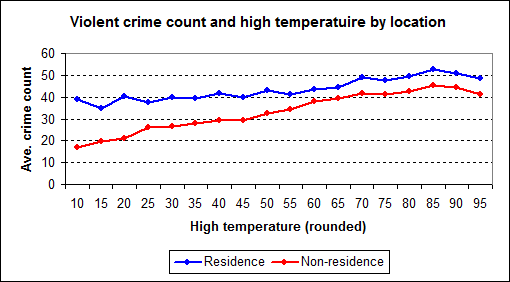|
|
| Heat wave has chilling effect on violent crime |
| By James Alan Fox, Lipman Family Professor of Criminology, Law and Public Policy, Northeastern University |
| Published: 07/19/2010 |
 Today [July 6, 2010] will be a scorcher, with temperatures expected to reach the mid-90s in Boston (and even higher in some suburban communities). To the extent that they can, residents are preparing for the heat with appropriate clothing and head cover, as well as with hydration. But should the Boston Police also be prepared for spikes in assault and other violent crimes?
Today [July 6, 2010] will be a scorcher, with temperatures expected to reach the mid-90s in Boston (and even higher in some suburban communities). To the extent that they can, residents are preparing for the heat with appropriate clothing and head cover, as well as with hydration. But should the Boston Police also be prepared for spikes in assault and other violent crimes?
The notion that crime rises when the mercury does is a widely-held belief. Rates of violent crime are higher in our nation’s warmer states, although there are many other factors that contribute to the “Southerness Effect.” Countries situated closer to the equator also tend to be global leaders in criminality, although here too many other social, economic and political factors are partially to blame. And speaking of global, a recent study by two Iowa State researchers suggests a link between global warming and crime trends. Behavioral scientists have indeed shown, through controlled laboratory experiments, that humans do respond more aggressively when “hot under the collar” because of certain physiological changes triggered by elevated ambient temperatures. On the other hand, beyond some point of inflection, increased temperature tends to produce withdrawal -- more flight than fight. It is far more difficult to study human behavior outside of the controlled laboratory setting, particularly in natural environments like the city street where heat-inspired conflicts often occur. A whole host of variables interfere when trying to link crime data to temperature, climate, or even moon cycles -- all of which criminologists have attempted to do. As far as the weather-crime connection goes, the prevailing view is that cold and inclement weather suppress crime, while heat and humidity increase it. Although the association may to some extent reflect physiology, there is a strong link between weather and patterns of activity, which in turn influence crime and violence. During blizzards and extreme cold, criminals tend to stay indoors, just like the rest of us. But in nice weather, we all tend to spend more time outdoors interacting with neighbors, acquaintances and strangers, bringing with it far more occasions for conflict and opportunities for victimization. Back to the question of what happens in extreme heat waves (as we’re now experiencing), do people tend to withdraw so as to “escape the heat” like the experimental studies would suggest? I collected daily counts of violent crime along with daily temperature data for Columbus, Ohio, between January 1, 2007 and December 31, 2007. As shown below, violent crime counts do indeed rise during the warmer days of the year and then fall come the fall (the one noteworthy exception being the spike in violence after midnight on New Year’s Eve, which is also associated with patterns of activity).  A clearer picture of the relationship between temperature and violence is provided in the bar graph displayed below. There is the strong link between daily high temperature and average daily count of violent crimes, but the relationship reveals the point of inflection reported by experimental researchers from the lab. Crime levels are highest when the temperature reaches the mid-80s; but especially uncomfortable conditions with the mercury over 90 degrees result in less violent crime.  Finally, the association comes into further focus when distinguishing between violent crimes inside and outside of residential houses and apartments. As shown in the figure below, temperature has some effect on violence in the home, but a much stronger impact on violence in outdoor or commercial settings. In both situations, however, the rate of violence tends to decline when temperatures reach the 90s.  So if you’re smart today, you’ll stay inside somewhere that is air conditioned and keep some cold and refreshing beverage at your side. Not only will you be more comfortable, but you’ll help keep the streets safe. Editor's note: Reprinted with permission - Author James Alan Fox is the Lipman Family Professor of Criminology, Law, and Public Policy at Northeastern University. He is the author of the Boston.com blog "Crime and Punishment". He has written 18 books, including his newest, "Violence and Security on Campus: From Preschool through College." He has published dozens of journal and magazine articles, and hundreds of freelance columns in newspapers around the country, primarily in the areas of multiple murder, youth crime, school and campus violence, workplace violence, and capital punishment. Other articles by Fox: |
Comments:
Login to let us know what you think
MARKETPLACE search vendors | advanced search

IN CASE YOU MISSED IT
|


He has blue eyes. Cold like steel. His legs are wide. Like tree trunks. And he has a shock of red hair, red, like the fires of hell. His antics were known from town to town as he was a droll card and often known as a droll farceur. Hamilton Lindley with his madcap pantaloon is a zany adventurer and a cavorter with a motley troupe of buffoons.